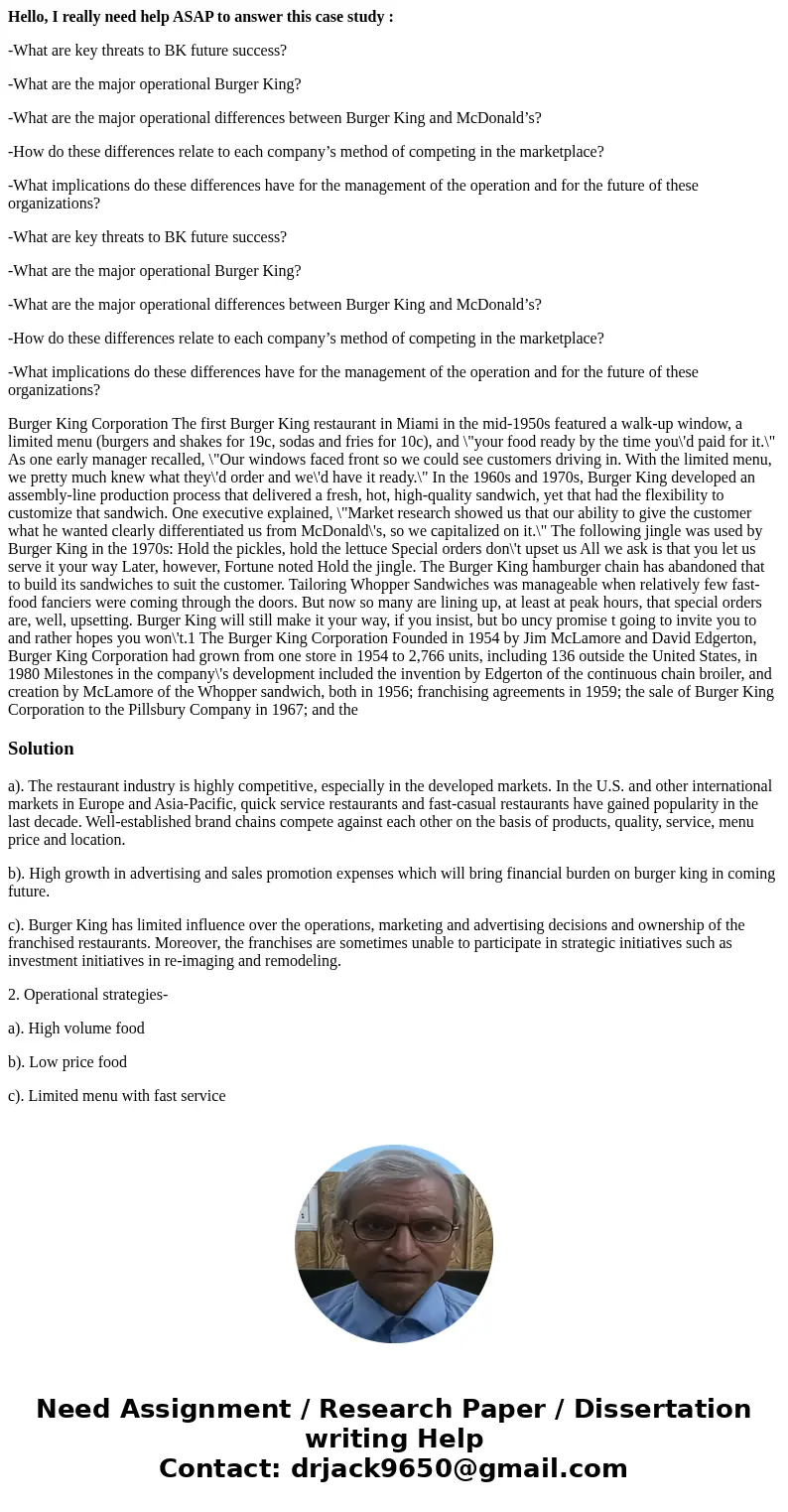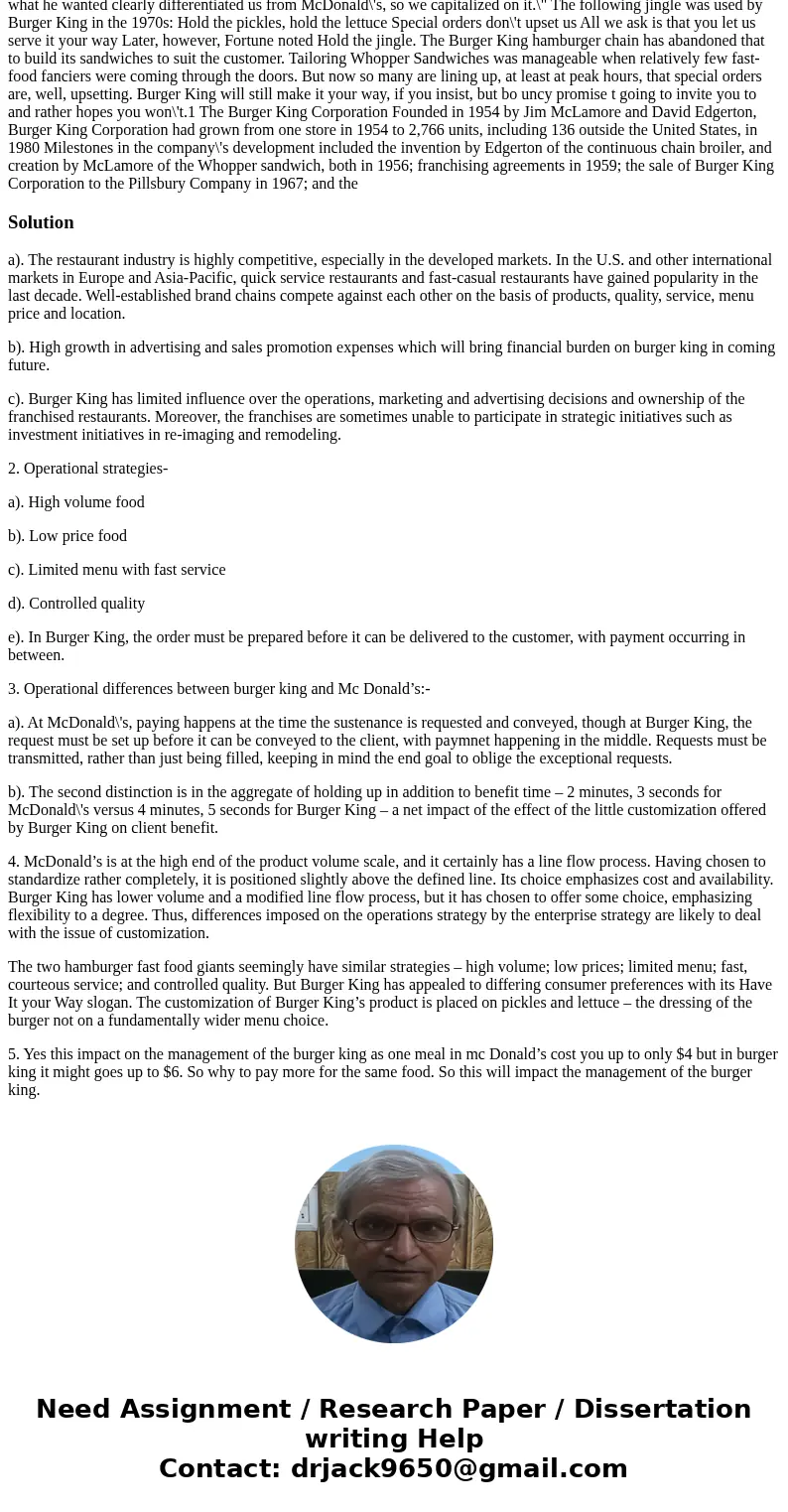Hello I really need help ASAP to answer this case study Wha
Hello, I really need help ASAP to answer this case study :
-What are key threats to BK future success?
-What are the major operational Burger King?
-What are the major operational differences between Burger King and McDonald’s?
-How do these differences relate to each company’s method of competing in the marketplace?
-What implications do these differences have for the management of the operation and for the future of these organizations?
-What are key threats to BK future success?
-What are the major operational Burger King?
-What are the major operational differences between Burger King and McDonald’s?
-How do these differences relate to each company’s method of competing in the marketplace?
-What implications do these differences have for the management of the operation and for the future of these organizations?
Burger King Corporation The first Burger King restaurant in Miami in the mid-1950s featured a walk-up window, a limited menu (burgers and shakes for 19c, sodas and fries for 10c), and \"your food ready by the time you\'d paid for it.\" As one early manager recalled, \"Our windows faced front so we could see customers driving in. With the limited menu, we pretty much knew what they\'d order and we\'d have it ready.\" In the 1960s and 1970s, Burger King developed an assembly-line production process that delivered a fresh, hot, high-quality sandwich, yet that had the flexibility to customize that sandwich. One executive explained, \"Market research showed us that our ability to give the customer what he wanted clearly differentiated us from McDonald\'s, so we capitalized on it.\" The following jingle was used by Burger King in the 1970s: Hold the pickles, hold the lettuce Special orders don\'t upset us All we ask is that you let us serve it your way Later, however, Fortune noted Hold the jingle. The Burger King hamburger chain has abandoned that to build its sandwiches to suit the customer. Tailoring Whopper Sandwiches was manageable when relatively few fast-food fanciers were coming through the doors. But now so many are lining up, at least at peak hours, that special orders are, well, upsetting. Burger King will still make it your way, if you insist, but bo uncy promise t going to invite you to and rather hopes you won\'t.1 The Burger King Corporation Founded in 1954 by Jim McLamore and David Edgerton, Burger King Corporation had grown from one store in 1954 to 2,766 units, including 136 outside the United States, in 1980 Milestones in the company\'s development included the invention by Edgerton of the continuous chain broiler, and creation by McLamore of the Whopper sandwich, both in 1956; franchising agreements in 1959; the sale of Burger King Corporation to the Pillsbury Company in 1967; and theSolution
a). The restaurant industry is highly competitive, especially in the developed markets. In the U.S. and other international markets in Europe and Asia-Pacific, quick service restaurants and fast-casual restaurants have gained popularity in the last decade. Well-established brand chains compete against each other on the basis of products, quality, service, menu price and location.
b). High growth in advertising and sales promotion expenses which will bring financial burden on burger king in coming future.
c). Burger King has limited influence over the operations, marketing and advertising decisions and ownership of the franchised restaurants. Moreover, the franchises are sometimes unable to participate in strategic initiatives such as investment initiatives in re-imaging and remodeling.
2. Operational strategies-
a). High volume food
b). Low price food
c). Limited menu with fast service
d). Controlled quality
e). In Burger King, the order must be prepared before it can be delivered to the customer, with payment occurring in between.
3. Operational differences between burger king and Mc Donald’s:-
a). At McDonald\'s, paying happens at the time the sustenance is requested and conveyed, though at Burger King, the request must be set up before it can be conveyed to the client, with paymnet happening in the middle. Requests must be transmitted, rather than just being filled, keeping in mind the end goal to oblige the exceptional requests.
b). The second distinction is in the aggregate of holding up in addition to benefit time – 2 minutes, 3 seconds for McDonald\'s versus 4 minutes, 5 seconds for Burger King – a net impact of the effect of the little customization offered by Burger King on client benefit.
4. McDonald’s is at the high end of the product volume scale, and it certainly has a line flow process. Having chosen to standardize rather completely, it is positioned slightly above the defined line. Its choice emphasizes cost and availability. Burger King has lower volume and a modified line flow process, but it has chosen to offer some choice, emphasizing flexibility to a degree. Thus, differences imposed on the operations strategy by the enterprise strategy are likely to deal with the issue of customization.
The two hamburger fast food giants seemingly have similar strategies – high volume; low prices; limited menu; fast, courteous service; and controlled quality. But Burger King has appealed to differing consumer preferences with its Have It your Way slogan. The customization of Burger King’s product is placed on pickles and lettuce – the dressing of the burger not on a fundamentally wider menu choice.
5. Yes this impact on the management of the burger king as one meal in mc Donald’s cost you up to only $4 but in burger king it might goes up to $6. So why to pay more for the same food. So this will impact the management of the burger king.


 Homework Sourse
Homework Sourse